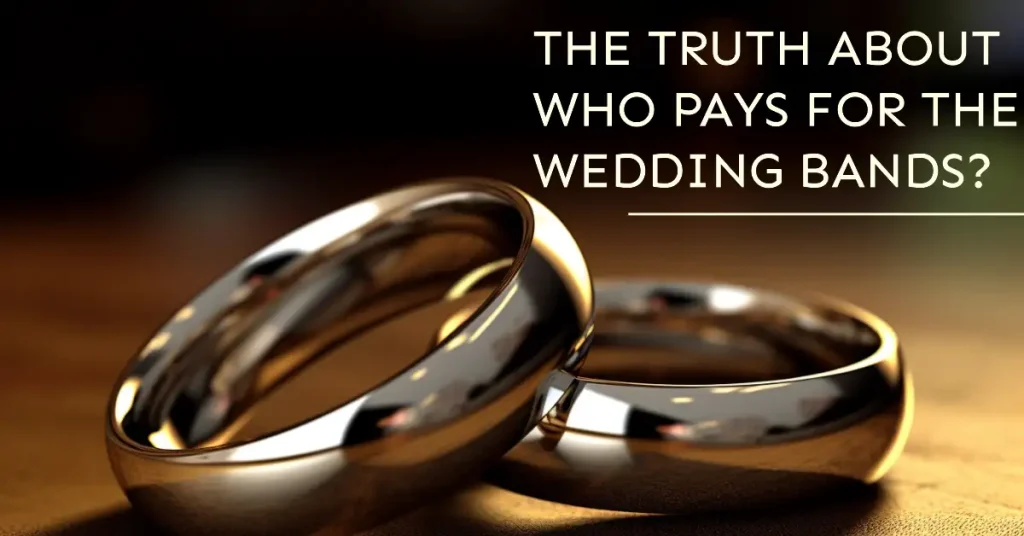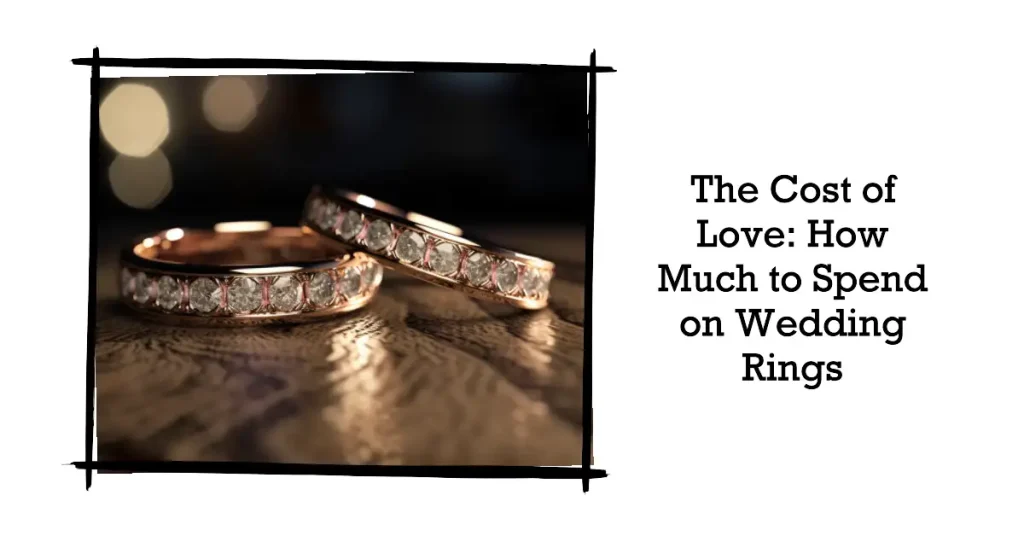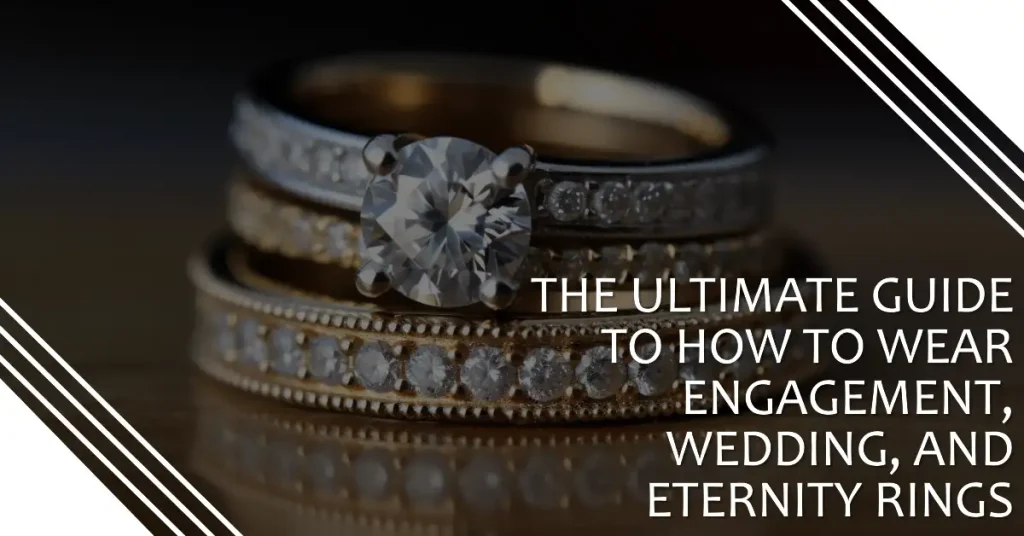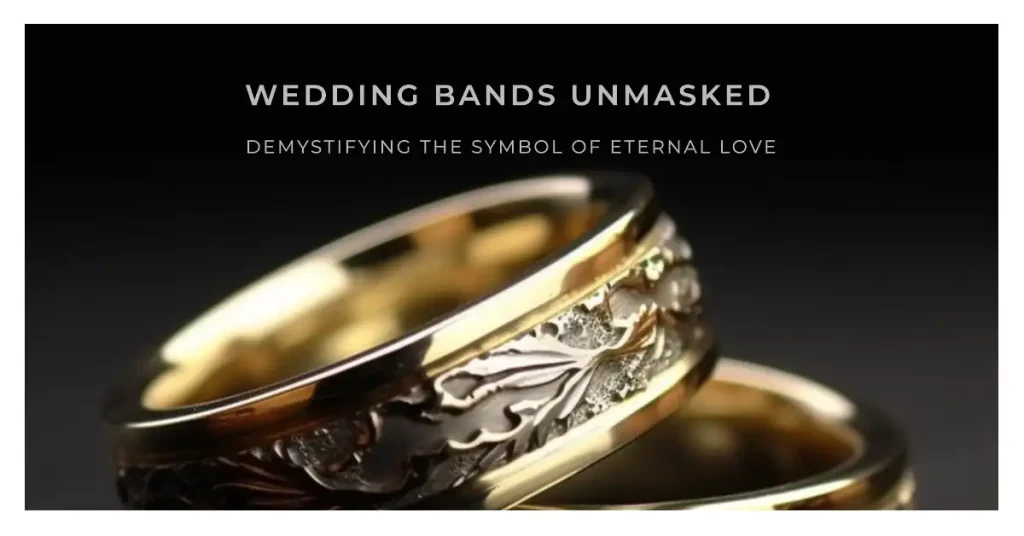Table of Contents
There’s something quite magical about planning a wedding, isn’t there? Every detail, every decision, brings you closer to that special day when you and your partner will stand before your loved ones, exchange your vows, and start a new chapter in your life. In this whirlwind of joyous chaos, there’s one tiny detail you might have wondered about: who pays for the wedding bands?
A Brief History of Wedding Bands
The history of wedding bands is a captivating journey that spans across cultures, eras, and even continents. The story weaves together strands of love, commitment, and enduring traditions. Let’s set out on this enchanting voyage together, shall we?
Ancient Beginnings
Imagine, if you will, an ancient Egyptian in love. Their fingers deftly weave together sedges, rushes, reeds, and perhaps even strands of hair. The result is a beautifully braided, circular token. With no beginning or end, these rings symbolize the eternity of love. These humble and poignant tokens of affection were possibly the earliest forms of what we now know as wedding bands.
- Carter, Lisa (Author)
- English (Publication Language)
- 107 Pages - 04/06/2024 (Publication Date) - Independently published (Publisher)
The Roman Influence
Now, let’s fast forward a bit to ancient Rome. Wedding bands became a legally binding contract, a sign of the groom’s claim on his bride. These early bands, often made of iron, were less about romance and more about ownership and legality. But the symbolism of wedding bands continued to evolve.
The Church’s Touch
As we step into the Middle Ages, the Church begins to play a role in wedding ceremonies. The symbolism of the wedding band is infused with a higher, spiritual meaning. The Church viewed the circular form of the band as a representation of divine perfection and eternity. This influence not only enhanced the romantic symbolism of the wedding band but also ingrained it in Christian matrimonial ceremonies.
From Decorative to Simple
The Renaissance period saw wedding bands taking on intricate and ornate designs, often set with gemstones. However, during the Victorian era, wedding bands swung back to simpler, more modest designs. This return to a classic form further solidified the notion of the wedding band as a symbol of eternal love and commitment.

The Modern Wedding Band
Fast forward to today, wedding bands, much like our relationships, come in a variety of shapes, sizes, and designs. While some opt for traditional gold bands, others might choose platinum, silver, or even silicone. Some may choose ornate designs with diamonds and other precious stones, while others may prefer a simple, minimalist band. Regardless of the design, the underlying symbolism remains the same – a timeless circle of love and commitment.
Understanding Wedding Finances
The labyrinth of wedding finances can often feel daunting, even mystifying. But, just like every maze has a way out, every aspect of wedding planning, including finances, can be successfully navigated with the right knowledge and guidance.
Traditional Allocation of Wedding Costs
Traditionally, the burden of wedding costs was allocated along familial lines. But what does that mean, exactly?
- The Bride’s Family: Historically, the bride’s family shouldered the lion’s share of the wedding costs. This included the reception, the bride’s attire, photography, flowers, and decorations, among other things.
- The Groom’s Family: The groom’s family, on the other hand, typically covered the costs of the rehearsal dinner, the bride’s rings, and often, the honeymoon.
This traditional division of expenses was a widely accepted practice for many years. However, with the societal changes of the past few decades, this structure has evolved quite a bit.
The Modern Shift in Wedding Finances
Fast forward to the 21st century, and you’ll find that the norms of wedding finance have become much more flexible. Modern couples are increasingly taking on a larger share of the financial responsibilities for their weddings. Here’s a glimpse into what’s changing:
- Shared Expenses: Today, it’s common for both the bride and the groom’s families to jointly shoulder the wedding costs. This is reflective of a more egalitarian approach to marriage and wedding planning.
- Couple-funded Weddings: An increasing number of couples are choosing to fund their weddings themselves, whether due to financial independence, later marriage ages, or simply a desire for more control over their celebration.
- Crowdfunded and Gifted Weddings: The advent of digital platforms has made crowdfunded or gifted weddings a possibility. Friends and family can contribute to various aspects of the wedding as their gift to the couple, easing the financial burden and allowing for a wider circle of participation.
Understanding the modern trends in wedding finances empowers you to make decisions that are comfortable and suitable for your personal situation. Remember, the most important aspect of navigating this maze is open and honest communication about financial expectations and capabilities, both as a couple and with your families.
The Traditional Approach
The tradition of who pays for the wedding bands has deep historical roots and is intertwined with cultural customs, societal norms, and even aspects of economic exchange. Let’s take a look at this classic scenario and its implications.
The Groom Pays for the Bride’s Wedding Band
The most prevalent traditional approach sees the groom taking up the responsibility of purchasing the bride’s wedding band. This gesture is viewed as a symbol of his commitment and his capacity to provide for the future family. But why did this tradition come about?
The roots of this custom can be traced back to the concept of the dowry and bride wealth. In many cultures, a dowry, a substantial transfer of goods or wealth, was given from the bride’s family to the groom or his family. Contrarily, bride wealth involved gifts given by the groom or his family to the bride’s family as a sort of compensation for their loss of a family member.
The groom’s purchase of the bride’s wedding band can be seen as a continuation of the bride wealth tradition, serving as a symbolic gesture reflecting his promise to take care of his bride.
The Bride’s Family Covers the Groom’s Wedding Band
On the flip side, traditionally, the bride’s family would bear the cost of the groom’s wedding band. This practice, again, links back to the dowry system. The bride’s family would often present gifts to the groom as part of the dowry. The groom’s wedding band can be considered one such gift, symbolizing their acceptance of him into their family.
The Meaning Beyond The Tradition
These practices might seem a bit antiquated in our modern world. Yet, they carry a historical significance and a sense of continuity that many couples find comforting and meaningful. These traditions, after all, are not just about who pays for what, but about the symbolic exchanges and the deeper meanings behind these gestures.

The Modern Approach
The turn of the century ushered in a new era of wedding traditions, reflecting the evolving dynamics of relationships. As we navigate these changes, we find a marked shift in the financial responsibilities associated with weddings, including the purchase of wedding bands. Let’s delve into this modern approach and its implications.
The Equality of Shared Costs
In the 21st century, it’s increasingly common for couples to share the costs associated with their wedding. This includes everything from the venue to the catering, and yes, the wedding bands. This trend is indicative of a larger societal shift towards greater financial equality within relationships.
In many instances, couples choose to jointly save for and purchase their own wedding bands. This act of shared responsibility often aligns with the couple’s broader financial practices, where both partners contribute towards shared goals.
A Symbol of Mutual Commitment
When a couple decides to split the cost of their wedding bands, it reflects their mutual commitment, not just to their impending marriage, but also to the financial responsibilities they will share in their life together. This act can serve as a powerful symbol of the balanced partnership they aspire to have.
Moreover, purchasing your own wedding bands can bring a sense of empowerment and agency. You’re not just a participant in the tradition; you’re actively shaping it to fit your values and your relationship.
The Influence of Changing Dynamics
This modern approach is also a reflection of the changing dynamics in relationships and societal norms. Today, partners often enter relationships as financially independent individuals. This independence doesn’t necessarily cease once the relationship begins. Instead, it evolves into a shared financial responsibility where major expenses, such as a wedding, are often handled together.
The Flexibility of Choice
The beauty of the modern approach lies in its flexibility. Some couples may choose to share the cost of the wedding bands equally, while others might decide on a different arrangement based on their unique circumstances. There are no rigid rules in the realm of love and marriage, and this holds true for who purchases the wedding bands.
Factors Influencing Who Pays
Deciding who will pay for the wedding bands can depend on a medley of factors. Each couple has a unique set of circumstances, traditions, and preferences that can greatly influence this decision. Let’s explore some of these influencing factors.
Cultural Norms
The culture and traditions you and your partner hail from can play a significant role in deciding who pays for the wedding bands. As we’ve seen, some cultures traditionally see the groom paying for the bride’s band and vice versa. These norms, though evolving, can still hold weight for many couples and families.
Personal Preference
Personal preference is another crucial factor. Perhaps you both cherish the tradition of the groom buying the bride’s band, or you prefer the modern approach of splitting the cost. Maybe you both wish to select and pay for your own bands. Your preferences can, and should, guide your decision-making process.
Financial Circumstances
Let’s not forget the role of financial circumstances. The reality of your combined financial situation can greatly influence who pays for the wedding bands. If one partner earns significantly more or has greater savings, they may choose to pay. Alternatively, couples may decide to split the cost based on their individual incomes.
A Matter of Principle
Sometimes, the decision can be a matter of principle. For example, you may both believe in sharing all financial responsibilities, or maybe you value the tradition of the groom purchasing the bride’s band. Principles, like preferences, can help shape your decision.
The Comfort Factor
Lastly, but perhaps most importantly, is what feels right for both of you. Each decision in your wedding planning process, including who pays for the wedding bands, should ultimately bring comfort and joy. If a certain approach or tradition doesn’t resonate with you or causes undue stress, it may be worth reconsidering.

Finding the Right Wedding Bands Within Your Budget
In the quest to find the perfect wedding bands that echo your personal style and align with your budget, patience and research are your most trusted allies. This task, though seemingly daunting, is entirely achievable. Here’s a guide to help you navigate this exciting journey.
The Art of Research
Before you set foot in a jewelry store or start browsing online, it’s essential to do your research. Understand the different types of materials used in wedding bands, from traditional gold and platinum to modern materials like titanium and tungsten. Each material has its own price range and characteristics, so make sure you choose one that suits your budget and lifestyle.
Patience is Key
Remember, this isn’t a race. Finding the right wedding bands is a process that requires time and patience. Take your time to explore your options, visit multiple jewelers, and browse through various online stores. Compare prices and styles, and don’t rush to make a decision.
Setting a Realistic Budget
A crucial step in this process is setting a realistic budget for your wedding bands. Consider your overall wedding budget and your financial situation. How much are you comfortable spending on your bands? Stick to this budget as you explore your options. Remember, the value of a wedding band lies in its symbolic meaning, not its price tag.
Making Informed Choices
Once you have done your research and set your budget, it’s time to make an informed choice. Keep in mind the style you want, the material that suits your lifestyle and budget, and the comfort factor—remember, you’ll be wearing this band every day.
Customization and Alternatives
Consider customization as an option. You could design your own wedding bands that reflect your personal style. Moreover, you don’t have to stick to traditional materials and designs. There are plenty of alternative, cost-effective materials like silicone, stainless steel, or wood that can be used to create unique and affordable wedding bands.
The Role of Sales and Discounts
Keep an eye out for sales, discounts, and promotions at jewelry stores and online platforms. These can greatly help in finding beautiful wedding bands that fit within your budget.
Etiquette Tips and Considerations
Navigating wedding finance conversations, especially those involving family members, can sometimes feel like traversing a minefield of traditions, expectations, and emotions. Here are some etiquette tips and considerations to help you gracefully handle these discussions.
Approach with Respect and Understanding
When engaging in conversations about who will pay for the wedding bands, always approach the discussion with respect and understanding. Remember, it might be as uncomfortable a topic for your family members as it is for you. A respectful and understanding demeanor can go a long way in ensuring smooth and productive discussions.
Be Mindful of Generational Differences
Different generations may have different views on wedding finances based on the traditions they grew up with. Parents or grandparents might hold certain expectations rooted in the customs they’re familiar with. Be mindful of these generational differences and try to appreciate their perspective even if it differs from yours.
Open, Honest Communication
Honesty is crucial. Communicate openly about your financial situation and your desires. If you and your partner have decided to split the cost of the wedding bands, explain your reasons. If you need financial help, don’t be afraid to ask. Transparency can prevent misunderstandings and hurt feelings down the line.
Consensus between You and Your Partner
Before you bring up the subject with family members, ensure you and your partner are on the same page. A united front will make the conversation easier and show that you’ve made the decision as a team.
Be Prepared for Different Reactions
Despite your best efforts, understand that everyone may not agree with your decision, and that’s okay. Be prepared for different reactions and handle them with grace and patience.
The Final Decision
Ultimately, the decision about who pays for the wedding bands should be one that you and your partner are comfortable with. It’s your special day, and the choices made should reflect your values and circumstances.

The Influence of Culture
Weddings around the world are colored by an array of traditions and customs that make them uniquely beautiful. One aspect that varies significantly across cultures is the tradition surrounding who pays for the wedding bands. While these norms are evolving, understanding and respecting cultural nuances is crucial.
Traditional Expectations
In many cultures, the expectation of who purchases the wedding bands has been shaped by long-standing traditions. For instance, in Western cultures, it’s traditionally the groom who purchases the bride’s ring, and vice versa.
In other cultures, such as in India, it’s often the bride’s family who bears the expense of all wedding jewelry, including the wedding bands. These traditional expectations, while still prevalent in some areas, have been evolving over time to adapt to changing societal norms.
Navigating Cultural Norms
Navigating cultural norms can be complex, but it’s essential to approach this task with respect and understanding. If you’re part of a multicultural couple, consider discussing your respective cultural norms and expectations around wedding expenses. This conversation can help you better understand each other’s perspectives and find a middle ground that respects both traditions.
A Celebration of Diversity
Remember, the variety of cultural traditions surrounding weddings is something to be celebrated. It reflects the beautiful diversity of our world. Whether you choose to follow traditional norms, adapt them to suit your circumstances, or create your own traditions, what matters most is that the choice aligns with your values and circumstances, and brings joy to both of you.
Conclusion
To sum it all up, the decision on who pays for the wedding bands is a personal one. It’s a choice that should reflect the comfort, financial status, and preference of you and your partner. The most important aspect is the love and commitment that these rings symbolize, rather than the financial logistics of their purchase.
Remember, there’s no right or wrong way to navigate this part of your journey. Every love story is unique, and so is every wedding. Embrace what works best for you and your partner. After all, these are not just bands of metal, but circles of love, signifying your commitment to a shared, beautiful future.
FAQs
Q: Are there any alternatives to purchasing expensive wedding bands?
A: Yes, couples have various options when it comes to wedding bands. They can choose more affordable options, such as simple bands or alternative materials, or even opt for personalized, handmade bands that may be less costly than traditional options.
Q: What if the couple cannot afford wedding bands?
A: If the couple is facing financial constraints, they can explore alternative options like borrowing or renting wedding bands. They can also consider postponing the purchase until they are in a better financial position.
Q: Should the cost of the wedding bands be included in the overall wedding budget?
A: Yes, it is advisable to include the cost of the wedding bands in the overall wedding budget. This helps ensure that all expenses are accounted for and helps the couple manage their finances effectively.
Q: What if the couple wants to splurge on more expensive wedding bands?
A: If the couple desires to invest in more expensive wedding bands, they can choose to contribute more financially or save up specifically for that purpose. It’s important to consider their overall budget and financial priorities before making such a decision.
Q: Should the couple consider matching or coordinating wedding bands?
A: Matching or coordinating wedding bands can be a symbolic and aesthetically pleasing choice. However, it is entirely optional and depends on the couple’s personal preferences. Some couples may opt for different styles that reflect their individual tastes.
Q: Can the cost of the wedding bands be negotiated or discounted?
A: Depending on the jeweler and the specific circumstances, it may be possible to negotiate or receive discounts on the cost of the wedding bands. It is worth exploring different options, comparing prices, and discussing potential discounts with jewelers to find the best deal.
Q: What if the couple decides not to exchange wedding bands?
A: The exchange of wedding bands is a longstanding tradition, but ultimately it is a personal choice. If the couple decides not to exchange wedding bands, they can explore alternative symbols of their commitment, such as personalized jewelry or other meaningful tokens.
Q: Can the couple receive wedding bands as gifts?
A: Yes, wedding bands can be given as gifts by family members, friends, or loved ones. It is not uncommon for parents or close relatives to offer to pay for the wedding bands as a generous gesture.
Q: Should the couple consider insuring their wedding bands?
A: Insuring wedding bands is a wise decision as it provides financial protection in case of loss, theft, or damage. Couples should inquire with their insurance provider about specific coverage options for jewelry and consider adding the wedding bands to their policy.
Q: What if the couple wants to include heirloom or family rings as their wedding bands?
A: Incorporating heirloom or family rings as wedding bands can add sentimental value to the ceremony. If the couple chooses to use heirloom rings, they may want to consider resizing or refurbishing them to suit their preferences or ensure they are in good condition for daily wear.
Q: Can the couple customize or personalize their wedding bands?
A: Absolutely! Couples can choose to customize or personalize their wedding bands to reflect their unique style and story. This can include engraving names, dates, or special messages, as well as selecting specific designs, materials, or gemstones that hold significance to them.
Q: When should the couple start shopping for wedding bands?
A: It is recommended to start shopping for wedding bands several months before the wedding to allow ample time for research, browsing options, trying on different styles, and placing orders. This helps avoid any last-minute rush or potential delays in receiving the bands.
Q: What if the couple changes their minds about the wedding bands after purchasing?
A: If the couple changes their minds about the wedding bands after purchasing, they should review the return and exchange policies of the jeweler. It’s important to understand any potential fees or limitations associated with returning or exchanging the bands and communicate with the jeweler to find a suitable solution.
Key Takeaways
- Historical Origins: Wedding bands have a rich history that dates back to ancient civilizations. From ancient Egypt to the Roman era and the Middle Ages, the symbolism of wedding bands has evolved to represent eternal love and commitment.
- Traditional Allocation of Wedding Costs: In the past, wedding costs were divided along familial lines, with the bride’s family shouldering most expenses and the groom’s family covering the rehearsal dinner and the groom’s wedding band.
- Modern Shift in Wedding Finances: In the 21st century, wedding finance norms have become more flexible. Many modern couples are sharing the financial responsibilities, jointly funding their weddings, or even opting for crowdfunded or gifted weddings.
- Traditional Approach: Traditionally, the groom pays for the bride’s wedding band, reflecting historical customs related to dowry and bride wealth. The bride’s family, in turn, would cover the cost of the groom’s wedding band as a symbol of acceptance.
- Modern Approach: In contemporary times, there is a growing trend of couples sharing the costs of their wedding bands. This approach reflects a commitment to financial equality and partnership.
- Factors Influencing Who Pays: The decision on who pays for the wedding bands depends on various factors, including cultural norms, personal preferences, financial circumstances, principles, and the comfort factor for the couple.
- Finding Wedding Bands within Budget: Researching different materials, setting a realistic budget, and exploring customization options or alternatives can help couples find the perfect wedding bands that fit their style and budget.
- Etiquette Tips for Discussing Wedding Finances: Approach discussions about wedding finances with respect and understanding. Be mindful of generational differences, practice open and honest communication, and ensure consensus between you and your partner before involving family members.
- Cultural Influence: Cultural norms and traditions play a significant role in who pays for the wedding bands. Couples from diverse cultural backgrounds should have conversations about their respective expectations and find a balance that respects both traditions.
- Personal Choice and Meaning: Ultimately, the decision on who pays for the wedding bands should be based on the comfort, financial status, and preference of the couple. The symbolic meaning of the rings and the love they represent outweigh the financial logistics of their purchase.
COPYRIGHT NOTICE
Please be advised that all images, designs, and creative content on this page are the exclusive property of TheIDoGuide.com and are protected under international copyright laws. The images may not be reproduced, copied, transmitted or manipulated without the written permission of TheIDoGuide.com.
Unauthorized use, distribution, display, or creation of derivative works of any images contained on this site, is strictly prohibited and can lead to legal penalties. We actively monitor for, and enforce, our copyright interests.
If you wish to use any of our images, kindly contact us to seek permission. Respect of copyright is not merely a legal requirement but also an acknowledgement and support of the hard work and creativity that goes into producing them.
Thank you for your understanding and cooperation.
© 2023, TheIDoGuide.com. All Rights Reserved.






